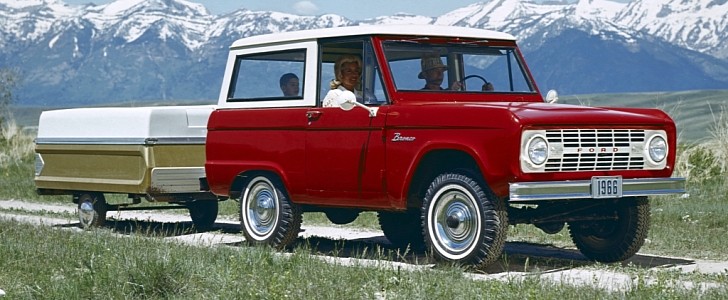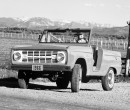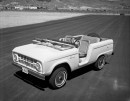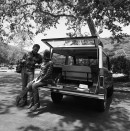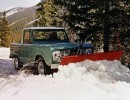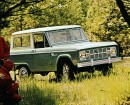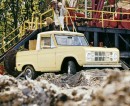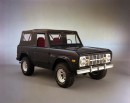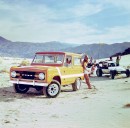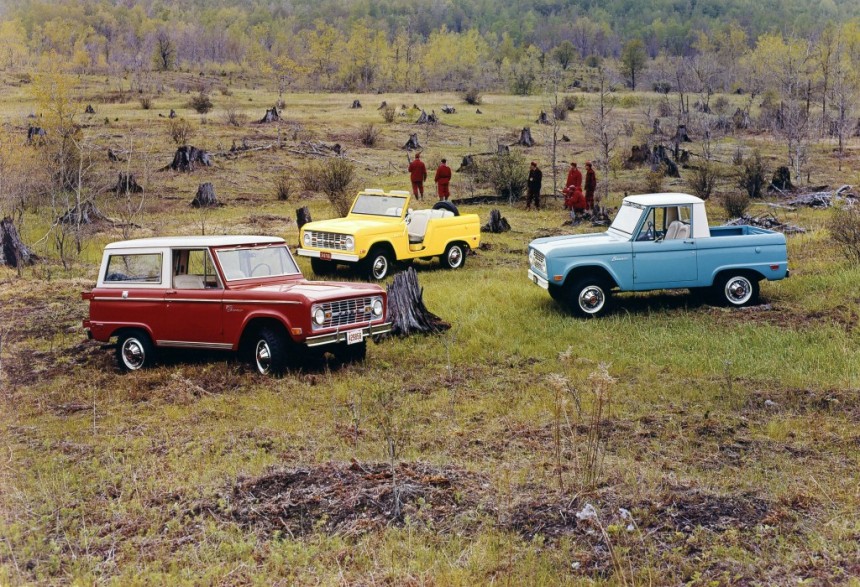Donald Nelson Frey started working at Ford in 1950. Described by Time as the sharpest idea man in Detroit, the product manager that gave us the original Bronco in 1965 for the 1966 model year worked together with Lee Iacocca to bring the Mustang to market. As you can tell from these monikers, both models are strongly connected to one another.
Iacocca was instrumental in designing the Mustang, which had been pursued by Frey with equal determination after Henry Ford II had rejected the idea a whopping four times. In an article from 2004 published by Northwestern, Frey also credits his kids for making the Mustang happen.
“I clearly remember sitting around the dining room table and my kids saying, ‘Dad, your cars stink. They're terrible. There's no pizzazz.' That started the whole thing.” If you browse through a brochure of the 1960 lineup, you’ll understand why Fords were regarded that way in that era.
Amid the incredible commercial success of the Mustang pony car that sold a million examples within two years of its launch, both Frey and Iacocca were looking to enter the off-road vehicle market to steal customers away from the Jeep CJ-5 and International Scout 80. They also wanted to attract a plethora of buyers that wouldn’t have considered such a vehicle in the first place, which is why the first-generation Bronco had to break the mold.
Contrary to current trends in the automotive industry, it’s utmost necessary to mention that utility vehicles were the exact opposite of popular back then. Jeep and International didn’t sell too many CJ-5s and Scouts in the early ‘60s, but Ford’s power duo wasn’t disheartened by these circumstances.
Come 1962, the Dearborn-based automaker extensively surveyed CJ-5 and Scout owners to understand what they like and loathe about their off-roaders. A memo dated July 11th, 1963, noted that both had poor comfort, rode pretty rough, and the NVH was unsatisfactory. That’s all Frey and Iacocca needed to start working on the Bronco, which sweetened the deal with gorgeous exterior styling and a powerful name, just like the ‘Stang.
October 23rd, 1963, is when the Product Planning Committee received the recommendation for a brand-new utility vehicle, codenamed Bronco. Just a week later, the G.O.A.T. acronym that stands for Goes Over All Terrain was used in an internal memo to indicate the newcomer’s off-road prowess.
McKinley Thompson, the first African American automobile designer working for the Ford Motor Company, is credited with penning the earliest sketches of the Bronco in July 1963. Don Frey describes the Bronco as “neither a conventional car nor a truck, but as a vehicle which combines the best of both worlds. It can serve as a family sedan, as sports roadster, as a snowplow, or as a farm or civil defense vehicle.” Coincidence or not, the boxy Bronco rolled out for the 1966 model year in 1965 with three body styles.
Wagon is how the Blue Oval marketed the utility vehicle, Sports Utility Vehicle referred to the half-cab truck, and the open-air version was called Roadster. Although it sounds fairly exotic, the Roadster was the least expensive Bronco because the doors and roof were optional extras. The spartan configuration translated to abysmal sales, totaling 5,000 units in three years of production, making the Roadster an extremely desirable blue-chip collectible.
The second-rarest body style is the pickup with 17,262 units, while the two-door wagon survived until 1977 with precisely 203,535 units to its name. These body styles are also called U14 for the half-cab truck and U15 for the utility vehicle, while the Roadster features a VIN that begins with U13.
Developed on a dedicated chassis not shared with any other Ford, Lincoln, or Mercury model, the Bronco offered four-wheel drive as standard to simplify production. The attached brochure for the 1966 model year notes 32.1 cubic feet (909 liters) of cargo capacity, Mono-Beam front suspension, a 33.6-foot turning radius, and a wheelbase of 92 inches (233.68 centimeters).
Two engines were available in the first year of production, a 170-cubic-inch sixer with 105 gross horsepower on deck and a 289-cubic-inch V8 with 200 ponies. Both were complemented by a synchronized three-speed manual transmission, a Dana 20 shift-on-the-fly transfer case, a Dana 30 front axle, and a Ford 9.0-inch rear axle. The front axle was replaced by the Dana 44 in 1971, and the front drum brakes were utilized until 1976, when a pair of rotors became available as an option. In addition, the steering box was upgraded with a quicker ratio (3.8 turns instead of 5.3 turns).
Ford enlarged the 289 engine to 302 cubic inches for the 1969 model year, and for 1973, the base 170 engine was replaced by a 200 straight-six. 1973 is also the year the Ford Motor Company offered a three-speed automatic transmission, a change that was best seen in the sales figures for 1974.
The Bronco was never the same again with the introduction of the second generation in 1977 for the 1978 model year on F-100 underpinnings instead of a unique platform. Ford had to make the transition to the full-size SUV segment because of the Chevrolet K5 Blazer. The Bronco soldiered on with F-Series bits and pieces until 1996 when the nameplate was dropped in favor of the Expedition to better compete with the Suburban and GMC Yukon.
Revived for the 2021 model year, the sixth-generation Bronco features the T6.2 platform that also underpins the 2023 Ranger mid-size workhorse.
“I clearly remember sitting around the dining room table and my kids saying, ‘Dad, your cars stink. They're terrible. There's no pizzazz.' That started the whole thing.” If you browse through a brochure of the 1960 lineup, you’ll understand why Fords were regarded that way in that era.
Amid the incredible commercial success of the Mustang pony car that sold a million examples within two years of its launch, both Frey and Iacocca were looking to enter the off-road vehicle market to steal customers away from the Jeep CJ-5 and International Scout 80. They also wanted to attract a plethora of buyers that wouldn’t have considered such a vehicle in the first place, which is why the first-generation Bronco had to break the mold.
Contrary to current trends in the automotive industry, it’s utmost necessary to mention that utility vehicles were the exact opposite of popular back then. Jeep and International didn’t sell too many CJ-5s and Scouts in the early ‘60s, but Ford’s power duo wasn’t disheartened by these circumstances.
Come 1962, the Dearborn-based automaker extensively surveyed CJ-5 and Scout owners to understand what they like and loathe about their off-roaders. A memo dated July 11th, 1963, noted that both had poor comfort, rode pretty rough, and the NVH was unsatisfactory. That’s all Frey and Iacocca needed to start working on the Bronco, which sweetened the deal with gorgeous exterior styling and a powerful name, just like the ‘Stang.
October 23rd, 1963, is when the Product Planning Committee received the recommendation for a brand-new utility vehicle, codenamed Bronco. Just a week later, the G.O.A.T. acronym that stands for Goes Over All Terrain was used in an internal memo to indicate the newcomer’s off-road prowess.
McKinley Thompson, the first African American automobile designer working for the Ford Motor Company, is credited with penning the earliest sketches of the Bronco in July 1963. Don Frey describes the Bronco as “neither a conventional car nor a truck, but as a vehicle which combines the best of both worlds. It can serve as a family sedan, as sports roadster, as a snowplow, or as a farm or civil defense vehicle.” Coincidence or not, the boxy Bronco rolled out for the 1966 model year in 1965 with three body styles.
The second-rarest body style is the pickup with 17,262 units, while the two-door wagon survived until 1977 with precisely 203,535 units to its name. These body styles are also called U14 for the half-cab truck and U15 for the utility vehicle, while the Roadster features a VIN that begins with U13.
Developed on a dedicated chassis not shared with any other Ford, Lincoln, or Mercury model, the Bronco offered four-wheel drive as standard to simplify production. The attached brochure for the 1966 model year notes 32.1 cubic feet (909 liters) of cargo capacity, Mono-Beam front suspension, a 33.6-foot turning radius, and a wheelbase of 92 inches (233.68 centimeters).
Two engines were available in the first year of production, a 170-cubic-inch sixer with 105 gross horsepower on deck and a 289-cubic-inch V8 with 200 ponies. Both were complemented by a synchronized three-speed manual transmission, a Dana 20 shift-on-the-fly transfer case, a Dana 30 front axle, and a Ford 9.0-inch rear axle. The front axle was replaced by the Dana 44 in 1971, and the front drum brakes were utilized until 1976, when a pair of rotors became available as an option. In addition, the steering box was upgraded with a quicker ratio (3.8 turns instead of 5.3 turns).
Ford enlarged the 289 engine to 302 cubic inches for the 1969 model year, and for 1973, the base 170 engine was replaced by a 200 straight-six. 1973 is also the year the Ford Motor Company offered a three-speed automatic transmission, a change that was best seen in the sales figures for 1974.
The Bronco was never the same again with the introduction of the second generation in 1977 for the 1978 model year on F-100 underpinnings instead of a unique platform. Ford had to make the transition to the full-size SUV segment because of the Chevrolet K5 Blazer. The Bronco soldiered on with F-Series bits and pieces until 1996 when the nameplate was dropped in favor of the Expedition to better compete with the Suburban and GMC Yukon.
Revived for the 2021 model year, the sixth-generation Bronco features the T6.2 platform that also underpins the 2023 Ranger mid-size workhorse.
